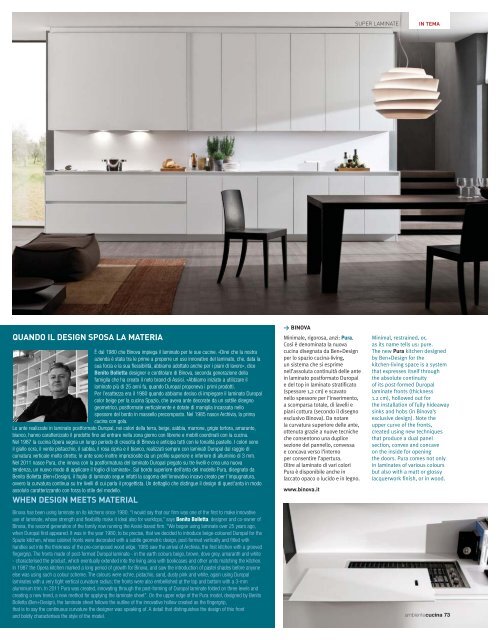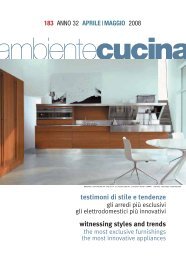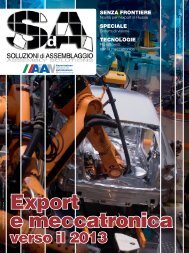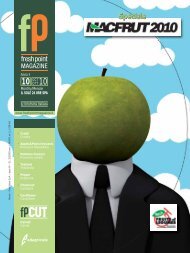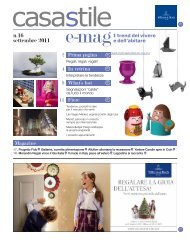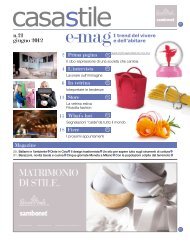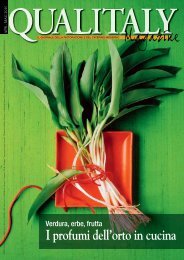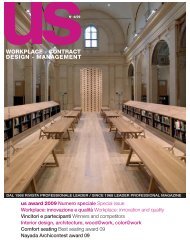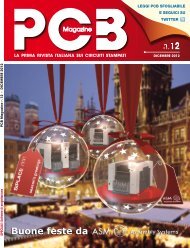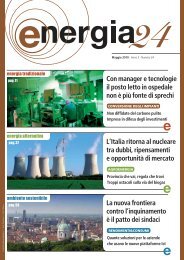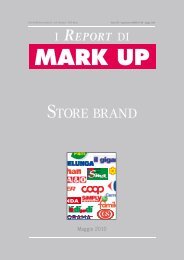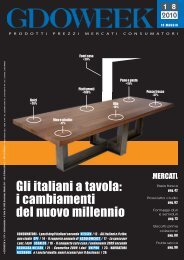super laminato - B2B24 - Il Sole 24 Ore
super laminato - B2B24 - Il Sole 24 Ore
super laminato - B2B24 - Il Sole 24 Ore
Create successful ePaper yourself
Turn your PDF publications into a flip-book with our unique Google optimized e-Paper software.
QUANDO IL DESIGN SPOSA LA MATERIA<br />
È dal 1980 che Binova impiega il <strong>laminato</strong> per le sue cucine. «Direi che la nostra<br />
azienda è stata tra le prime a proporre un uso innovativo del <strong>laminato</strong>, che, data la<br />
sua forza e la sua flessibilità, abbiamo adottato anche per i piani di lavoro», dice<br />
Benito Bolletta designer e contitolare di Binova, seconda generazione della<br />
famiglia che ha creato il noto brand di Assisi. «Abbiamo iniziato a utilizzare il<br />
<strong>laminato</strong> più di 25 anni fa, quando Duropal proponeva i primi prodotti.<br />
Per l’esattezza era il 1980 quando abbiamo deciso di impiegare il <strong>laminato</strong> Duropal<br />
color beige per la cucina Spazio, che aveva ante decorate da un sottile disegno<br />
geometrico, postformate verticalmente e dotate di maniglia incassata nello<br />
spessore del bordo in massello precomposto. Nel 1985 nasce Archivia, la prima<br />
cucina con gola.<br />
Le ante realizzate in <strong>laminato</strong> postformato Duropal, nei colori della terra, beige, sabbia, marrone, grigio tortora, amaranto,<br />
bianco, hanno caratterizzato il prodotto fino ad entrare nella zona giorno con librerie e mobili coordinati con la cucina.<br />
Nel 1987 la cucina Opera segna un lungo periodo di crescita di Binova e anticipa tutti con le tonalità pastello. I colori sono<br />
il giallo ocra, il verde pistacchio, il sabbia, il rosa cipria e il bianco, realizzati sempre con laminati Duropal dal raggio di<br />
curvatura verticale molto stretto; le ante sono inoltre impreziosite da un profilo <strong>super</strong>iore e inferiore di alluminio di 3 mm.<br />
Nel 2011 nasce Pura, che innova con la postformatura del <strong>laminato</strong> Duropal piegato su tre livelli e crea una nuova<br />
tendenza, un nuovo modo di applicare il foglio di <strong>laminato</strong>». Sul bordo <strong>super</strong>iore dell’anta del modello Pura, disegnato da<br />
Benito Bolletta (Ben+Design), il foglio di <strong>laminato</strong> segue infatti la sagoma dell’innovativo incavo creato per l’impugnatura,<br />
ovvero la curvatura continua su tre livelli di cui parla il progettista. Un dettaglio che distingue il design di quest’anta in modo<br />
assoluto caratterizzando con forza lo stile del modello.<br />
WHEN DESIGN MEETS MATERIAL<br />
Binova has been using laminate on its kitchens since 1980. “I would say that our firm was one of the first to make innovative<br />
use of laminate, whose strength and flexibility make it ideal also for worktops,” says Benito Bolletta, designer and co-owner of<br />
Binova, the second generation of the family now running the Assisi-based firm. “We began using laminate over 25 years ago,<br />
when Duropal first appeared. It was in the year 1980, to be precise, that we decided to introduce beige-coloured Duropal for the<br />
Spazio kitchen, whose cabinet fronts were decorated with a subtle geometric design, post-formed vertically and fitted with<br />
handles set into the thickness of the pre-composed wood edge. 1985 saw the arrival of Archivia, the first kitchen with a grooved<br />
fingergrip. The fronts made of post-formed Duropal laminate - in the earth colours beige, brown, dove grey, amaranth and white<br />
- characterised the product, which eventually extended into the living area with bookcases and other units matching the kitchen.<br />
In 1987 the Opera kitchen marked a long period of growth for Binova, and saw the introduction of pastel shades before anyone<br />
else was using such a colour scheme. The colours were ochre, pistachio, sand, dusty pink and white, again using Duropal<br />
laminates with a very tight vertical curvature radius; the fronts were also embellished at the top and bottom with a 3-mm<br />
aluminium trim. In 2011 Pura was created, innovating through the post-forming of Duropal laminate folded on three levels and<br />
creating a new trend, a new method for applying the laminate sheet”. On the upper edge of the Pura model, designed by Benito<br />
Bolletta (Ben+Design), the laminate sheet follows the outline of the innovative hollow created as the fingergrip,<br />
that is to say the continuous curvature the designer was speaking of. A detail that distinguishes the design of this front<br />
and boldly characterises the style of the model.<br />
> BINOVA<br />
Minimale, rigorosa, anzi: Pura.<br />
Così è denominata la nuova<br />
cucina disegnata da Ben+Design<br />
per lo spazio cucina-living,<br />
un sistema che si esprime<br />
nell’assoluta continuità delle ante<br />
in <strong>laminato</strong> postformato Duropal<br />
e del top in <strong>laminato</strong> stratificato<br />
(spessore 1,2 cm) e scavato<br />
nello spessore per l’inserimento,<br />
a scomparsa totale, di lavelli e<br />
piani cottura (secondo il disegno<br />
esclusivo Binova). Da notare<br />
la curvatura <strong>super</strong>iore delle ante,<br />
ottenuta grazie a nuove tecniche<br />
che consentono una duplice<br />
sezione del pannello, convessa<br />
e concava verso l’interno<br />
per consentire l’apertura.<br />
Oltre al <strong>laminato</strong> di vari colori<br />
Pura è disponibile anche in<br />
laccato opaco o lucido e in legno.<br />
www.binova.it<br />
SUPER LAMINATE<br />
IN TEMA<br />
Minimal, restrained, or,<br />
as its name tells us: pure.<br />
The new Pura kitchen designed<br />
by Ben+Design for the<br />
kitchen-living space is a system<br />
that expresses itself through<br />
the absolute continuity<br />
of its post-formed Duropal<br />
laminate fronts (thickness<br />
1.2 cm), hollowed out for<br />
the installation of fully hideaway<br />
sinks and hobs (in Binova’s<br />
exclusive design). Note the<br />
upper curve of the fronts,<br />
created using new techniques<br />
that produce a dual panel<br />
section, convex and concave<br />
on the inside for opening<br />
the doors. Pura comes not only<br />
in laminates of various colours<br />
but also with a matt or glossy<br />
lacquerwork finish, or in wood.<br />
ambientecucina 73


